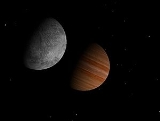
HD 154345 b
Encyclopedia
HD 154345 b, is a Jupiter-sized extrasolar planet
orbiting the star
HD 154345
.
method to detect the small wobbling movement of the star caused by the gravity of the planet. The discovery was confirmed in May 2007.
with a mass at least slightly less than that of Jupiter
and is likely to be a near twin of Jupiter, estimated to be around the same size, or slightly larger. It may also harbor a system of moons and rings. It orbits its parent star at the distance of 4.18 AU. Its orbital period
is about 9.095 Earth years and its orbit is circular.
Extrasolar planet
An extrasolar planet, or exoplanet, is a planet outside the Solar System. A total of such planets have been identified as of . It is now known that a substantial fraction of stars have planets, including perhaps half of all Sun-like stars...
orbiting the star
Star
A star is a massive, luminous sphere of plasma held together by gravity. At the end of its lifetime, a star can also contain a proportion of degenerate matter. The nearest star to Earth is the Sun, which is the source of most of the energy on Earth...
HD 154345
HD 154345
HD 154345 is a G-type dwarf star located in northern Hercules. It is not visible to the naked eye since this star is below +6.50 magnitude, but using binoculars it is an easy target.-Planetary system:...
.
Discovery
Wright et al. discovered the planet in March 2006 using the radial velocityRadial velocity
Radial velocity is the velocity of an object in the direction of the line of sight . In astronomy, radial velocity most commonly refers to the spectroscopic radial velocity...
method to detect the small wobbling movement of the star caused by the gravity of the planet. The discovery was confirmed in May 2007.
Characteristics
The planet is a gas giantGas giant
A gas giant is a large planet that is not primarily composed of rock or other solid matter. There are four gas giants in the Solar System: Jupiter, Saturn, Uranus, and Neptune...
with a mass at least slightly less than that of Jupiter
Jupiter
Jupiter is the fifth planet from the Sun and the largest planet within the Solar System. It is a gas giant with mass one-thousandth that of the Sun but is two and a half times the mass of all the other planets in our Solar System combined. Jupiter is classified as a gas giant along with Saturn,...
and is likely to be a near twin of Jupiter, estimated to be around the same size, or slightly larger. It may also harbor a system of moons and rings. It orbits its parent star at the distance of 4.18 AU. Its orbital period
Orbital period
The orbital period is the time taken for a given object to make one complete orbit about another object.When mentioned without further qualification in astronomy this refers to the sidereal period of an astronomical object, which is calculated with respect to the stars.There are several kinds of...
is about 9.095 Earth years and its orbit is circular.

